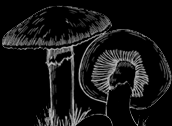Mycology Projects for Citizen Scientists
The projects below summarize some of the questions that local mushroomers have asked each other and wondered about for years. We've gathered these questions here in the hope of coordinating the efforts of citizen scientists to help answer them. Many of the species and ecological patterns involved occur throughout the Pacific states; so although our research will be done in Santa Cruz County, our findings will be relevant for a broader area. If you are interested in helping with any of these projects or have a question you would like to see added, please contact us.
UCSC Fungal Herbarium Sequencing Project
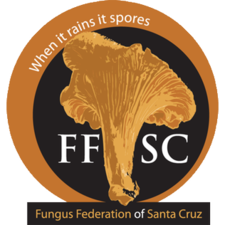 This is an ongoing project to obtain basic DNA sequence data for the fungi found in our county.
Generous funding for the project has come entirely from the Fungus Federation of Santa Cruz.
The herbarium specimens are house at the UC Santa Cruz Museum of Natural History Collections, and the photographs associated with the sequenced specimens are found throughout this site.
Student interns at UCSC are georeferencing and cataloguing these and many hundreds of other specimens.
A newly established internship will have students measuring and making micro-photos of spores from the herbarium specimens.
For a list of the specimens we have sequenced, full profiles of those species, as well as more information about this project, visit this link:
This is an ongoing project to obtain basic DNA sequence data for the fungi found in our county.
Generous funding for the project has come entirely from the Fungus Federation of Santa Cruz.
The herbarium specimens are house at the UC Santa Cruz Museum of Natural History Collections, and the photographs associated with the sequenced specimens are found throughout this site.
Student interns at UCSC are georeferencing and cataloguing these and many hundreds of other specimens.
A newly established internship will have students measuring and making micro-photos of spores from the herbarium specimens.
For a list of the specimens we have sequenced, full profiles of those species, as well as more information about this project, visit this link:
UCSC Fungal Herbarium Sequencing Project
Natural History of the Suillus/Gomphidiaceae Association
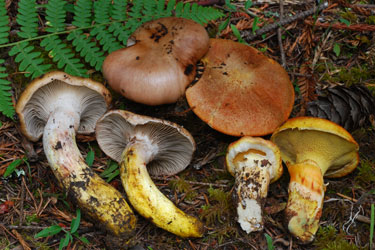 Close spatial associations between species of Gomphidius and Chroogomphus with Suillus have been noted in forest ecosystems in North America and Europe, and micromorphological and genetic work by Olsson et al, 2000 suggested that members of the Gomphidiaceae are likely parasites of Suillus.
Many mushroom enthusiasts have noted that each Gomphidius or Chroogomphus species appears to show a preference for a particular Suillus species. These correlations suggests that the Gomphidius parasites may have adaptated to specialize on their host Suillus species.
Close spatial associations between species of Gomphidius and Chroogomphus with Suillus have been noted in forest ecosystems in North America and Europe, and micromorphological and genetic work by Olsson et al, 2000 suggested that members of the Gomphidiaceae are likely parasites of Suillus.
Many mushroom enthusiasts have noted that each Gomphidius or Chroogomphus species appears to show a preference for a particular Suillus species. These correlations suggests that the Gomphidius parasites may have adaptated to specialize on their host Suillus species.
Citizen scientists will be able to inform our understanding of these relationships by contributing their observations to this project. Our goals are as follows.
- Assemble a list of Gomphidius/Chroogomphus species and their Suillus host preferences.
- Establish transects and surveying protocols to accumulate data on the proportion of Suillus patches in an area that are apparently parasitized by Gomphidiaceae.
- Perform long-term monitoring plots on parasitized Suillus mycelia; measuring fruitbody production, biomass, and persistence to accumulate anecdotal evidence on competitive outcomes.
Taxonomy and Distribution of Ganoderma in Central California
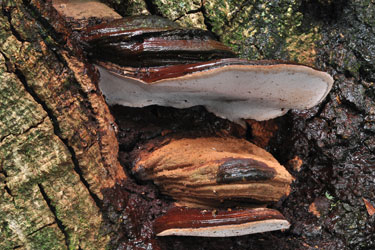 In Santa Cruz County, most historical records of Ganoderma refer to G. applanatum.
It has been suggested that G. brownii may be a more appropriate name for the common Ganoderma occuring in the county (and perhaps coastal California in general), but there has been no effort to rigorously verify the characters currently used for field identification (hoof-shaped versus fan-shaped fruitboides and yellow versus white young pore surface).
In Santa Cruz County, most historical records of Ganoderma refer to G. applanatum.
It has been suggested that G. brownii may be a more appropriate name for the common Ganoderma occuring in the county (and perhaps coastal California in general), but there has been no effort to rigorously verify the characters currently used for field identification (hoof-shaped versus fan-shaped fruitboides and yellow versus white young pore surface).
In an effort to shed light on the presence of the UCSC MycoTeam is making collections of Ganoderma from the UCSC Campus and using spore measurements paired with macromorphological data and photographs of sampled specimens taken in the field. Additionally, each fruitbody is marked with a unique number in nail polish to enable tracking of year-to-year changes in the shape of the fruitbody.
So far, our data indicate that G. brownii is by far the more common species on the UCSC Campus.
Visual Identification of Red-and-yellow Stemmed PseudoXerocomoid Boletes
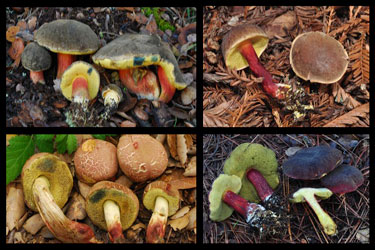 There are relatively few boletoid taxa in Santa Cruz County, and most are well-known named species.
However, the complex of species around B. chrysenteron/B. truncatus present both nomenclatural and identification difficulties.
None are generically correctly named (being neither Boletus s.s. nor Xerocomus s.s.). Both species are likely going by misapplied names (the types for the two mentioned species are European and Eastern, respectively), and along with B. zelleri are routinely misidentified by both novice and experienced mycotaxonomists.
There are relatively few boletoid taxa in Santa Cruz County, and most are well-known named species.
However, the complex of species around B. chrysenteron/B. truncatus present both nomenclatural and identification difficulties.
None are generically correctly named (being neither Boletus s.s. nor Xerocomus s.s.). Both species are likely going by misapplied names (the types for the two mentioned species are European and Eastern, respectively), and along with B. zelleri are routinely misidentified by both novice and experienced mycotaxonomists.
Although macroscopically somewhat confusing, the microscopic characters separating each species are unambiguous and easily assessed. Careful study over the past few years has yielded a number of criteria that can be used to make accurate macroscopic identifications of these species. By harnessing the large number of fruitbodies of these taxa available at forays and fairs, we can photograph, microscopically examine, and voucher specimens in order to make the dataset supporting these criteria more definitive.
Death Cap Host Oak Monitoring
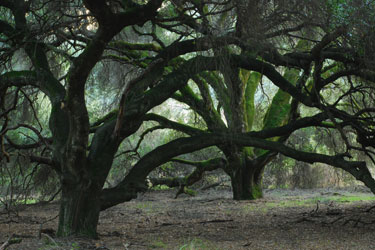 It has been hypothesized that the invasion of Amanita phalloides into California's Live Oak (Quercus agrifolia) habitats may come at the expense of native mycorrhizal species associated with these oaks.
Native mycorrhizal fungi may be detrimentally affected either by competition for soil resources, or by direct exclusion from space on host root tips.
It has been hypothesized that the invasion of Amanita phalloides into California's Live Oak (Quercus agrifolia) habitats may come at the expense of native mycorrhizal species associated with these oaks.
Native mycorrhizal fungi may be detrimentally affected either by competition for soil resources, or by direct exclusion from space on host root tips.
Citizen scientists will establish and monitor long-term plots centered around small isolated oak groves and individual trees. The presence or absence, estimated biomass and abundance of fruitbodies of Amanita phalloides will be assessed yearly, and will be compared to the same indices for native EM fungi fruiting on the same plots.
Plots of varying ages will be used, and the degree of root-tip monopolization by Amanita phalloides will be investigated by take soil cores from plot subsections. Experimental plantings of sterile-reared oaks may be undertaken with the help of UCSC Undergraduates in order to more rigorously investigate the effect of colonization by native versus invasive EM fungi.
Moths and Mushrooms - Investigating the Effects of Periodic Massive Host Defoliation on the ECM Fungal Community
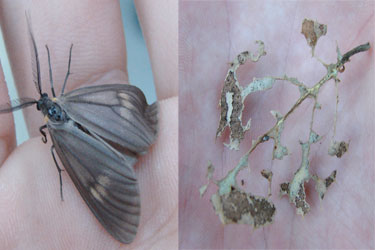 Central California's Live Oaks (Quercus agrifolia) experience defoliation by larval California Oak Moths (Phryganidia californica) during the summer and early fall at nearly-regular two-to-three year intervals. The extent of the defoliation varies from minor reduction in total leaf surface area to nearly complete skeletonization of the live oak canopy.
Central California's Live Oaks (Quercus agrifolia) experience defoliation by larval California Oak Moths (Phryganidia californica) during the summer and early fall at nearly-regular two-to-three year intervals. The extent of the defoliation varies from minor reduction in total leaf surface area to nearly complete skeletonization of the live oak canopy.
